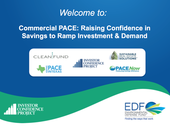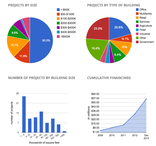“What do I think about 2014? I think it’s going to be a breakout year for PACE...”
- David Gabrielson, Executive Director of PACEnow

On this webinar we were privileged to have an all-star panel consisting of some of the leading PACE experts from across the country. Introductions and overviews were given by Matt Golden, Senior Energy Finance Consultant at EDF and ICP Lead, and by David Gabrielson, Executive Director at PACEnow. This was followed by a lively panel discussion fielding questions from our audience. The panel included Brian McCarter, CEO at Sustainable Real Estate Solutions, Charlene Heydinger, Executive Director at Keeping PACE in Texas, and John Kinney, CEO at Clean Fund.
You can download a PDF of the presentation from this webinar or view the webinar below:
 Click to Enlarge
Click to Enlarge PACE Programs are Growing - David Gabrielson, PACEnow:
In 2010 there were only 2 states containing a few PACE funded projects, California and Colorado. Today, there are 7 states with PACE funded projects and 26 Commercial PACE platforms operating throughout the country (see PACEnow Infographic). Furthermore, 208 projects have been completed totaling over $63 million.
Success in Connecticut - Brian McCarter, Sustainable Real Estate Solutions:
Under the direction of the Clean Energy Finance and Investment Authority (CEFIA) Connecticut Commercial PACE programs have been growing since their implementation a year ago. For example, 200 contractors have been trained on integrating Commercial PACE into the project development process and 200 applications have been received worth around $75 million in proposed project value. Stay tuned, because later in February CEFIA plans to announce a PACE industry event with the sale of the first portfolio of CPACE projects to a third party capital provider, valued at $7.5 million.
Protecting the Consumer - Charlene Heydinger, Keeping PACE in Texas:
Texas has 1,200 municipalities and 245 counties, and each one will determine if they want a PACE program. Uniformity is at the forefront for Keeping PACE in Texas, simply because of the state’s size. By commencing Commercial PACE in a homogenous way, it allows for more stable metrics and the hope that transaction costs can be limited and more user friendly.
The Triple Bottom Line - John Kinney, Clean Fund:
PACE programs can’t work without aligning interested parties. Vendors and real estate owners need to have the resources to interact with each other and to understand the metrics involved. Additionally, PACE programs imply a public / private partnership between the government and a range of private sector stakeholders including finance companies, ESCOs, building owners, utilities, and many others - making it even more important for these projects to have a triple bottom line impact.

 RSS Feed
RSS Feed